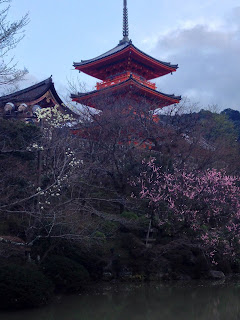During
a recent visit to Japan, my friend and I were able to visit Kyoto. Going around
Kyoto is quite easy since there are buses and trains that can bring you to
various temples and well-known spots.
For
a day trip where you plan to go to several places, it would be good to get a
Kyoto City Bus & Kyoto bus one-day pass card that is sold at 500 Yen at the
Kyoto Tourist Information office at the ground floor of the Kyoto train station. It gives unlimited access
on bus rides in Kyoto valid for 1 day. With the card, you will be able to save
on bus fare expense since taking a one way bus trip from Kyoto train station costs
around 230 Yen.
One
of the places we visited in Kyoto is the Nijo Castle, a UNESCO World Heritage
site.
Nijo Castle was built by the Tokugawa shogunate in 1603 for the defense of the Kyoto Imperial Palace and also served as official residence for visiting shoguns. The palace is divided into three areas: Honmaru(main circle of defense), NInomaru(secondary circle of defense) and a circuit style garden that encircles the two structures.
Nijo Castle was built by the Tokugawa shogunate in 1603 for the defense of the Kyoto Imperial Palace and also served as official residence for visiting shoguns. The palace is divided into three areas: Honmaru(main circle of defense), NInomaru(secondary circle of defense) and a circuit style garden that encircles the two structures.
 |
| The entrance gate to Nijo Castle |
 |
| Ninomaru palace at Nijo Castle |
 |
| Wood carving on the top entrance door of the Ninomaru |
The castle's structures shows traditional Japanese architecture.
 |
| The circuit style garden at Nijo castle |
 |
| A view of the Honmaru at Nijo Castle |
 |
| Honmaru area at Nijo Castle |
 |
| The inner part of the castle is surrounded by a moat. |
 |
 |
| Large koi fishes can be seen in the pond as one walks through the bridge that leads to the inner part of the castle |
Visitors are not allowed to take photos inside the palace area. Apart from the exquisitely painted walls and doors in the rooms of the palace, one interesting feature of the Ninomaru Palace at Nijo Castle are the corridor floors known as “nightingale floors”. The floors squeak like birds when one walks on it and it helped protect the occupants from sneak attacks and assassins. There are also special doors where the shogun’s bodyguard could sneak out to protect him in case there is an attack.
Nijo
Castle is also one of the locations included in the movie “The Last Samurai”
which starred Tom Cruise.
Another
UNESCO World Heritage site we visited is the Kiyomizudera Temple.
Kiyomizudera temple is also known as the “Pure Water Temple” and was named after the Otawa waterfall. It is one of the most celebrated temples in Japan.
The temple's main hall structure is made of wood and no nails were used when it was built.
Kiyomizudera temple is also known as the “Pure Water Temple” and was named after the Otawa waterfall. It is one of the most celebrated temples in Japan.
The temple's main hall structure is made of wood and no nails were used when it was built.
 |
| Main Hall of the Kiyomizudera |
 |
| A city view of Kyoto from Kiyomizudera |
 |
| Visitors can choose to drink from one of the 3 streams of the Otawa waterfall and drink for health, longevity or success in studies |
 |
| The pagoda at the Kiyomizudera |



No comments:
Post a Comment